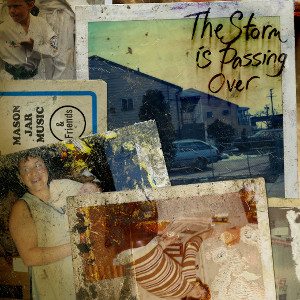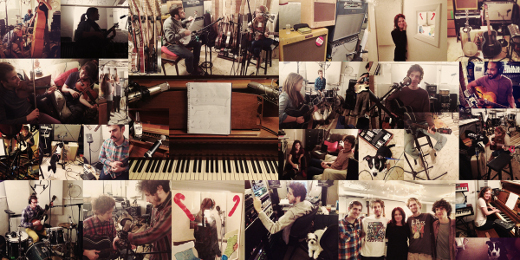15 Songs in 14 Days: Making “The Storm Is Passing Over” Sandy Benefit Album
KENSINGTON, BROOKLYN: The mantra of Brooklyn multimedia collective Mason Jar Music is “Preserving Analog Principles in a Digital Age”. But that applies to a lot more than just recording techniques.
In keeping with that grounded philosophy, MJM has just released a heartfelt Hurricane Sandy benefit album called The Storm Is Passing Over, an all-star collection of indie-folk artists who recorded fifteen classic American storm songs. 100% of donations exchanged for the recordings — available now at thestormispassingover.com — will go directly to Occupy Sandy’s ongoing relief work in New York City and the tri-state area.
MJM had to draw deeply on their experience of pulling off complex projects — for the likes of Feist and Alicia Keys – to create The Storm. The album’s 15 tracks were recorded and mixed over just a two-week period in December, 2012, by a range of artists that included Roseanne Cash, Abigail Washburn and Bela Fleck, Town Hall, Tift Merritt, and many more.
While some of the musicians worked remotely from their homes and studios in Nashville, Portland, and Paris, most of them came to record at MJM’s facility in Kensington, Brooklyn. Collaborating with MJM co-founders Dan Knobler and Jon Seale, along with the collective’s highly dedicated staff, the group workshopped highly moving new interpretations of classic American songs. Next, the album was finalized in the suite of Arf! Mastering’s Alan Silverman.
Each track of The Storm is Passing Over centers around a real performance, recorded live, and the raw artistic passion is palpable. Knobler told SonicScoop how this essential project – equal parts marathon and sprint – came together so quickly.
Once MJM decided to do a benefit project for Sandy, how did you select the form it would take — indie folk artists re-imagining American storm songs?
Jon Seale, the other MJM co-founder, called me late one night and left a voicemail that essentially said, “I have a great idea, call me ASAP.”
The original idea was as simple as NYC artists doing public domain songs, but we quickly reached out to our friends at Dust-to-Digital about curating a list of old songs centered around themes of storms, floods, disasters and recoveries.
With such a short timeline for the project, we ended up culling the list ourselves – leaning towards a lot of old delta blues and bluegrass ballads. We sent out a list of two dozen or so songs, and made suggestions for certain artists, but generally let people pick songs that they gravitated to. We encouraged artists to suggest other songs, and a handful of artists came back with great ideas as well.
There was obviously a time-sensitive need to record the album as fast as possible. What are the logistics of tracking and mixing 14 different artists in just two weeks?
It was a crazy month! We sent out the tune list in late November, scheduled most of the sessions for mid-December, and mixed it in a series of marathon 9 am – 4 am days/nights.
For the main tracking days, we generally had two or three artists coming in each day. We had our house rhythm section (drummer Jason Burger and bassist Zack Rosen) try to keep their calendars as open as possible. Jon and I both play a variety of instruments as well, so there was a lot of passing instruments back and forth and last minute, i.e. “Hey, it’d be great to have perc on this, let’s call Jason” situations. In fact, Aoife O’Donovan did exactly that and called Punch Brothers banjo extraordinaire Noam Pikelny, who showed up 20 minutes later and cut a beautiful track together.
After a while, we stopped setting up the studio in advance, because artists would keep coming in and the song would go in a completely different direction than what we had expected.
The sessions would go something like this: artist comes in, hangs out for a bit and listens to some of the other tunes; they play down the tune solo; we talk about instrumentation and arrangement and how the track would fit into the rest of the record; assemble the musicians to play it down a few times; set up mics and start tracking.
We encouraged everyone to cut as much live as possible, doing vocals with the rhythm section on almost every track, using headphones only when we had to. Several tracks are entirely live and “Let The Mermaids Flirt With Me” (by The Relatives) is the first take.
That’s a good blend of planning and spontaneity! Tell us about the MJM facility, and some of the tracking tools/mixing techniques you had on hand that you leaned on most heavily in the process.
We have a medium-sized live room (large for NYC) with just enough of a room sound to give drums and electric instruments a bit of space and to keep acoustic instruments clean and close.
We definitely utilized a well-placed room mic often — particularly our Peluso 22 47 in omni — usually run through our old JoeMeek channel strip, which has a surprisingly nice quick compressor. One trick we used several times was splitting the vocal mic(s) and running them through an old RCA classroom speaker wired to our Mackie PA. The speaker breaks-up beautifully and sounds great with a touch of slap — that’s a big part of the vocal sound on the opening track “Wayfaring Stranger” by Lucius.
One other great trick we picked up was using the one octave of bass pedals on our Hammond Model M to approximate some type of distorted bowed upright bass.
On the plugin front, we used a lot of the SoundToys Decapitator and Echo Boy, PSP Old Timer and Vintage Warmer, and borrowed a great trick from our friend Sean O’Brien: using just touch of the Digidesign “Lo-Fi” on shakers and tambourines, recorded with a Coles 4038.
Those are some quality tips. On another front, how was MJM’s background as multimedia producers particularly helpful in pulling this project together?
I think our experience putting together large-scale multimedia projects and events was a great help for this endeavor. In addition to the simple benefit of knowing a lot of great musicians, Jon and I work so much together that we kind of share a brain and can delegate tasks, keep each other informed, and always keep the ball rolling forward.
We also had several epic GoogleDocs to organize song selection and scheduling.
This may sound obvious, but why do you think it’s particularly important for those involved in the recording arts to step up and produce benefit projects at a time like this — how can audio professionals and artists take this project as an inspiration to help out the next time we’re needed?
One positive thing to come out of the storm was a reminder of a greater sense of community in New York City. I think seeing people band together to help one another made people all around the city more likely to think about their neighbors and what their neighborhood and communities means to them.
I think this project has helped to connect some of the dots in the Brooklyn indie-folk world. It was great to have so many musicians and artists in and out of the studio, hearing each other’s tracks and trading stories. For us, having the opportunity to put some lesser-known artists on the same record as big names like Rosanne Cash and Abigail Washburn was a big plus.
In addition to music being a powerful emotional release for people going through tough times, if there is ever a way to convince people to pay for music, giving 100% of revenue to storm victims is a pretty compelling case.
Amen! Lastly, how can people help “The Storm Is Passing Over” become a success?
Donate, download, and help us spread the word!
— David Weiss
Please note: When you buy products through links on this page, we may earn an affiliate commission.








